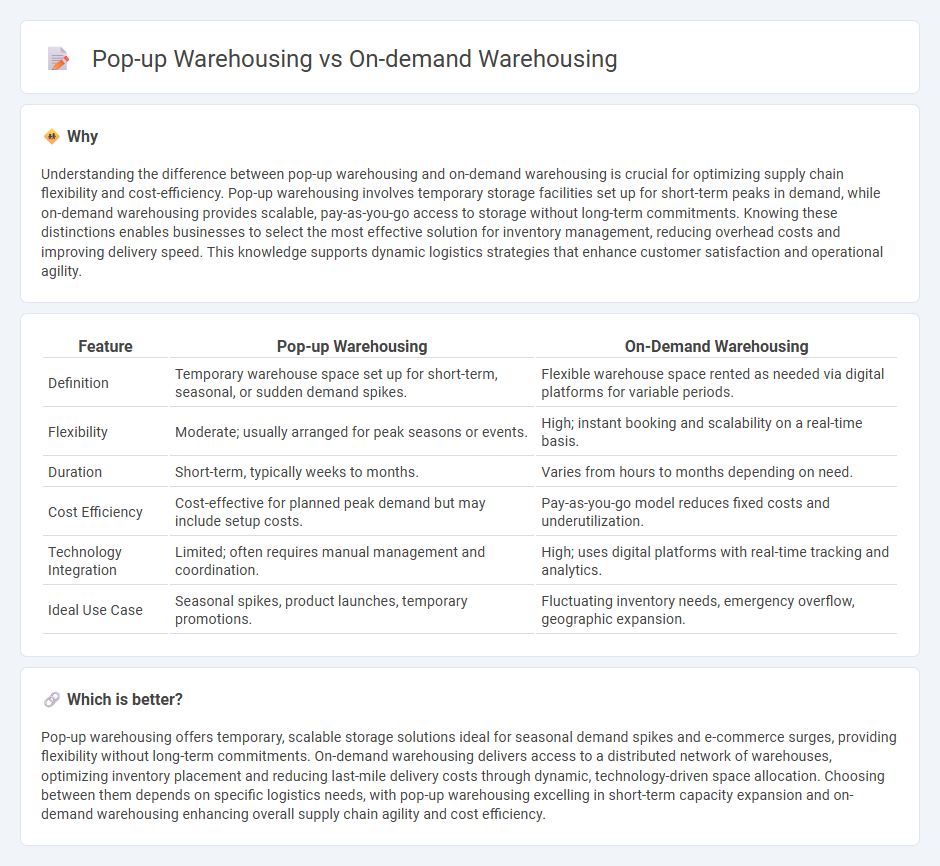
Pop-up warehousing offers flexible, temporary storage solutions ideal for seasonal demand spikes, while on-demand warehousing provides scalable, real-time inventory management through a network of distributed facilities. Both models optimize supply chain efficiency by reducing transportation costs and enhancing inventory visibility. Discover how these innovative logistics strategies can transform your warehousing approach.
Why it is important
Understanding the difference between pop-up warehousing and on-demand warehousing is crucial for optimizing supply chain flexibility and cost-efficiency. Pop-up warehousing involves temporary storage facilities set up for short-term peaks in demand, while on-demand warehousing provides scalable, pay-as-you-go access to storage without long-term commitments. Knowing these distinctions enables businesses to select the most effective solution for inventory management, reducing overhead costs and improving delivery speed. This knowledge supports dynamic logistics strategies that enhance customer satisfaction and operational agility.
Comparison Table
| Feature | Pop-up Warehousing | On-Demand Warehousing |
|---|---|---|
| Definition | Temporary warehouse space set up for short-term, seasonal, or sudden demand spikes. | Flexible warehouse space rented as needed via digital platforms for variable periods. |
| Flexibility | Moderate; usually arranged for peak seasons or events. | High; instant booking and scalability on a real-time basis. |
| Duration | Short-term, typically weeks to months. | Varies from hours to months depending on need. |
| Cost Efficiency | Cost-effective for planned peak demand but may include setup costs. | Pay-as-you-go model reduces fixed costs and underutilization. |
| Technology Integration | Limited; often requires manual management and coordination. | High; uses digital platforms with real-time tracking and analytics. |
| Ideal Use Case | Seasonal spikes, product launches, temporary promotions. | Fluctuating inventory needs, emergency overflow, geographic expansion. |
Which is better?
Pop-up warehousing offers temporary, scalable storage solutions ideal for seasonal demand spikes and e-commerce surges, providing flexibility without long-term commitments. On-demand warehousing delivers access to a distributed network of warehouses, optimizing inventory placement and reducing last-mile delivery costs through dynamic, technology-driven space allocation. Choosing between them depends on specific logistics needs, with pop-up warehousing excelling in short-term capacity expansion and on-demand warehousing enhancing overall supply chain agility and cost efficiency.
Connection
Pop-up warehousing and on-demand warehousing are connected through their flexible and scalable storage solutions tailored to meet fluctuating demand in logistics. Both approaches leverage temporary or short-term warehouse spaces to optimize inventory distribution and reduce costs during peak seasons or unexpected surges. Advanced technology platforms integrate real-time data to streamline space allocation, enhancing supply chain agility and responsiveness.
Key Terms
On-demand warehousing:
On-demand warehousing offers flexible, scalable storage solutions by allowing businesses to rent warehouse space only when needed, optimizing inventory management and reducing fixed costs. Unlike pop-up warehousing, which is temporary and event-driven, on-demand warehousing provides continuous access to space tailored for fluctuating supply chain demands. Explore how on-demand warehousing can streamline your logistics and improve operational efficiency.
Flexibility
On-demand warehousing offers unparalleled flexibility by allowing businesses to scale storage space instantly based on fluctuating inventory needs without long-term commitments. Pop-up warehousing provides temporary, location-specific storage solutions ideal for seasonal spikes or quick regional expansions, emphasizing rapid deployment and convenience. Explore further to understand which warehousing strategy best enhances your supply chain agility and operational efficiency.
Technology platforms
On-demand warehousing platforms leverage advanced algorithms and real-time data analytics to match supply and demand efficiently, offering flexibility and scalability in inventory management. Pop-up warehousing solutions emphasize rapid deployment through streamlined digital interfaces, enabling short-term storage needs often related to seasonal peaks or promotional events. Explore how these technology platforms transform supply chain agility and operational costs in detail.
Source and External Links
On-Demand Warehouse: Definition, Examples, and Uses - On-demand warehousing is a flexible, cost-effective solution allowing businesses to rent storage space only when needed, ideal for fluctuating inventory demands and offering benefits like faster fulfillment, reduced fixed costs, and flexible scaling without long-term contracts.
On-Demand Warehousing 101: What is On-Demand Warehousing - This model uses a marketplace and transactional pricing to enable retailers and brands to quickly secure flexible warehousing and fulfillment solutions with no long-term commitments by connecting them with providers who have excess capacity.
On-demand Warehousing Market Size & Share Report, 2030 - The global on-demand warehousing market, valued at $9.7 billion in 2023, is forecasted to grow rapidly to $26.2 billion by 2030, driven by e-commerce growth, technology integration, and demand for sustainable, flexible storage and fulfillment solutions across multiple industries.
 dowidth.com
dowidth.com